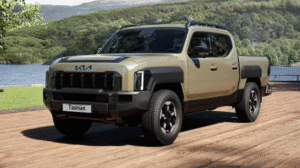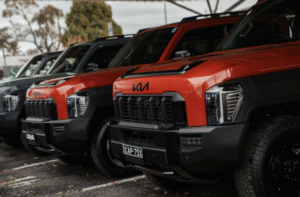
Credit: Tynan Motors
Kia has officially entered the dual‑cab ute arena with the 2025 Tasman, fully forged for Australian terrain and expectations. With an off‑road test drive deep into New South Wales, practical design upgrades and unrelenting ambition, Kia is eyeing the same buyer base that made the Ford Ranger and Toyota HiLux household names.
The Essentials in Brief
- The Tasman features a 2.2‑litre turbo‑diesel engine producing 154 kW and 440 Nm, routed through an eight‑speed automatic transmission.
- It offers 3,500 kg towing capacity, over 1,000 kg payload ratings, and a Gross Vehicle Mass of 3,250 kg.
- Ride height and terrain clearance are generous—252 mm of ground clearance with approach, ramp‑over and departure angles tailored for the rough stuff.
- Pricing ranges from around A$46,500 for the entry‑level 4×2 dual‑cab model up to about A$77,990 for the fully loaded X‑Pro flagship.
This entry price undercuts many factory V6 competitors, while the top‑end sits squarely in the shock‑absorbing, all‑terrain league.
Cabin Crafted for Australian Use
Walk inside any Tasman model, and it’s clear Kia aimed high on cabin tech. Dual 12.3‑inch screens for the infotainment and instrument cluster are standard—even in base models. Wireless Apple CarPlay, intuitive voice control, and a digital climate hub sit front and centre. The rear cabin earns praise, too: heated rear seats and a hidden storage locker under the bench make longer trips more comfortable.
For a launch ute, it feels genuinely modern—and competitive—not just in hardware, but in user experience.
Off-Road Confidence in the X‑Pro Variant

Credit: CarExpert
The X‑Pro grade brings trail-ready equipment—electronic rear locking differential, terrain modes including mud, sand, rock and snow, and the clever X‑Trek feature, which acts as a low-speed off‑road cruise control. At Bathurst, tyres bit into slippery inclines with reliability while skid plates and protective body cladding fended off rough ground.
Kia’s ladder-frame chassis, raised ride height and well-calibrated torque delivery made off-road handling intuitive—even for relatively inexperienced drivers.
Performance & Real-World Capability
On sealed roads, Tasman delivers refinement and steady power delivery. The turbo-diesel engine is smooth, but it doesn’t surprise—it feels honed rather than heroic.
Where the vehicle shows its limits is towing or climbing steep, loaded terrain. With 440 Nm on hand, it lags behind segment leaders like the V6 Ranger (600 Nm) or top-spec HiLux. For light towing and unladen hauls, it’s capable. But for heavier loads, drivers may wish for more grunt.
Existing BTU testing shows fuel use around 9.2 L/100 km, a slight step above Kia’s claimed 8.1 L/100km—fair for a ladder-frame 4×4, but room for optimisation remains.
Design That Divides
The Tasman‘s styling is bold, unconventional, and undeniably divisive. With Kia’s “Opposites United” lighting cues and sharp edges, it looks nothing like the brand’s heritage SUVs. Some buyers will love the originality—it stands out. Others may find it overly polarising compared to the more conservative lines of its rivals.
Interestingly, Kia leaned into that debate with high-profile ad campaigns featuring local athletes and even Rafael Nadal, emphasising relevance over convention.
Ownership Experience & Running Costs
Kia backs the Tasman with a generous seven‑year unlimited‑kilometre warranty and seven years of capped-price servicing. Annual service costs for 4×4 variants average around A$585, which is higher than some rivals but offset by the long warranty and included roadside assistance.
Driver safety equipment is comprehensive: autonomous emergency braking, adaptive cruise control, blind‑spot monitoring, and five-star ANCAP accreditation. The main caution is that lower-tier models without pedestrian protection add-on remain unrated.
Now Comes the Real Test
Kia has poured substantial effort into tailored design and rugged testing in Australia. Local teams participated deeply in development, tuning chassis dynamics and equipment to suit the Aussie lifestyle. If the brand nails reliability and support, the Tasman could capture a serious market share—even as a newcomer.
Recent reviews rate the Tasman “very good” overall, offering praise for its ride and interior—but consistently noting it needs more power and improved servicing affordability.
Summary: Where Kia Tasman Stands Today
| Strengths | Trade-offs |
| Modern, user‑friendly cabin with high‑end technology | Styling may not appeal to all buyers |
| Strong off‑road hardware in flagship X‑Pro | Modest power output and torque |
| Excellent payload and towing for a 2.2L diesel | Service costs slightly higher than key rivals |
| Competitive pricing across the range | Long‑term towing performance yet to be proven |
Final Word
The Kia Tasman isn’t a creature of habit—it’s a bold statement. It throws down a gauntlet to traditional utes by offering high-tech touches, competent off-road capability, and competitive towing in a distinct package.
While the 2.2L diesel might feel underpowered in some scenarios, the Tasman shines where it counts: during daily drives, comfort zones, and camp-out weekends. Its strengths lie in smart engineering and modern user experience rather than brute force.
As Kia’s first true shot at the Australian ute trophy, the Tasman has arrived with confidence. It may not win every head turn—but it definitely earns respect on the road.

